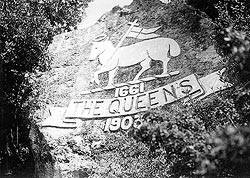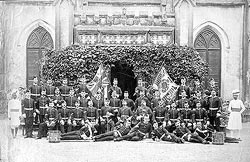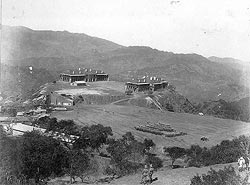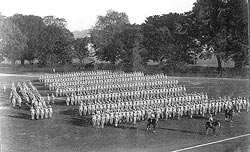Return to India
 |
| Cap badges in stone - 1661 - 1903, Khyber Pass. (Click to enlarge) |
Masters referred to “that inglorious campaign”. There was no further action for 1st Queen’s after their return to Rawalpindi except for a threat of trouble in the Malakand and on the Chitral road north of the Khyber valley in December 1898 which caused them to mobilize in less than six hours and move to the area. But it came to nothing. The Battalion moved to Sialkot and Amritsar in 1904 and to Agra in 1907 when two companies were detached to Delhi. On 2nd December 1908 1st Queen’s embarked for Aden.
1st Surreys left Gibraltar for India in December 1884 and at Suez exchanged 257 officers and men with the 2nd Battalion, receiving that number of those who were liable for further Indian service. It proved to be an uneventful tour. The battalion was stationed initially in the east at Bareilly and Ranikhet, and then successively at Allahabad, Calcutta and Agra where there was an epidemic of enteric fever. In 1896 it was at Jhansi, in 1899 at Lucknow where it remained until January 1903. It was then relieved by 2nd Surreys from South Africa and returned to England.
| 1st Bn The Queen’s Royal Regiment Church Parade Dagshai Parade Ground, 1897. (Click to enlarge) |
1st Bn The East Surrey Regiment
Dum Dum, 1891. (Click to enlarge) |
 |
| 1st Bn The East Surrey Regiment
The Corporals, Calcutta 1890. Khyber Pass. (Click to enlarge) |
2nd Surreys saw no service on the North West Frontier but their tour included three years in Burma from 1910 to 1913 at Meiktila, Mandalay and further north on manoeuvres up to the Yunnan border with China. They diverted to Chittagong and Dacca on their journey back to India in order to show the flag. They were then stationed briefly at Bareilly and Jhansi before returning to England in 1914.
Service in India away from the frontier involved much training, frequent long marches and manoeuvres. The highlights were the moves to the hill stations during the hot weather, parades and inspections, and the competitions. In 1905 1st Queen’s won the trophy instituted by Lord Kitchener for the battalion in India adjudged to be the most efficient in terms of satisfactory conduct, sound administration and the highest readiness for active service. In 1906 2nd Surreys were the Southern India Command Musketry Champions. Meanwhile the Indian Army, which had stagnated during the South African War, was being extensively reformed by Lord Kitchener who had become Commander-in-Chief in 1904. Regiments were re-grouped and re-numbered, a system of Army commands with divisions and brigades on a permanent basis was introduced, and re-equipment took place.
Related


